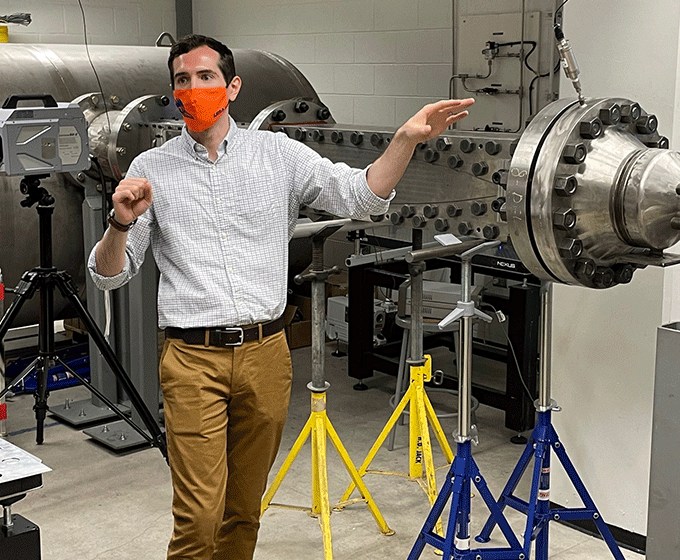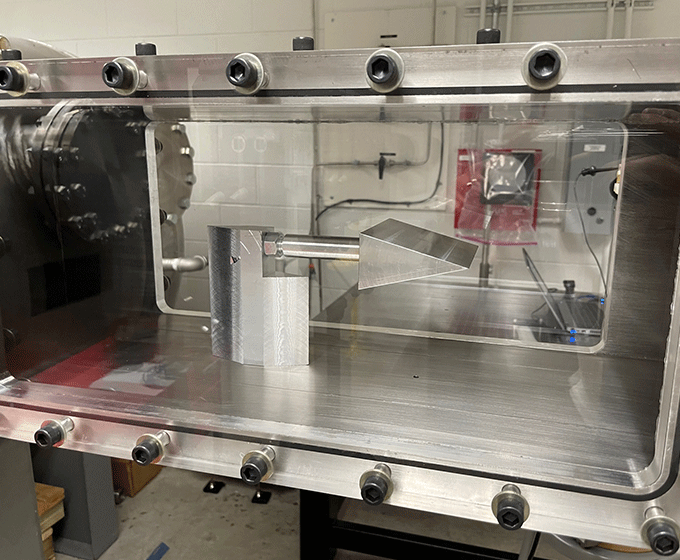
Aerodynamics professor Chris Combs and his team operate the new state-of-the-art Mach 7 Ludwieg Tube Wind Tunnel in the UTSA Hypersonics Lab. It's able to conduct a variety of tests under Mach 7 conditions, which is seven times the speed of sound.
MAY 18, 2021 — UTSA has a new state-of-the-art research facility now that the Mach 7 Ludwieg Tube Wind Tunnel has been completed after more than three years of construction. At 50 feet long and weighing more than 7,000 pounds, it operates at the UTSA Hypersonics Lab under the direction of Chris Combs, Dee Howard Endowed Assistant Professor in Aerodynamics in the UTSA Department of Mechanical Engineering.
Able to conduct a variety of tests under Mach 7 conditions (equivalent to traveling over 5,000 miles per hour at sea level), this type of wind tunnel is only available at a select number of American universities, in addition to a few in operation at the Department of Defense, NASA and national lab facilities.
“I'd put ours up with anybody else's in terms of Mach 7 testing situations we can reproduce in our lab, so it’s very unique what we’ve brought online,” Combs said. “Couple that with our high-speed cameras and non-intrusive diagnostic capability, and it's exceptionally rare to have those both under one roof at a university that is student-operated.”
This Mach 7 speed test was captured on UTSA’s Photron FastCam SA-Z video camera that records up to 2 million frames per second. The schlieren imaging technique visualizes events like shock waves and turbulent structures in wind tunnel flows.
The wind tunnel was one of Combs’ first priorities when he was recruited to develop an aerospace program at the university. He had to design the wind tunnel to fit in a specific long, rectangular room. The highly-polished, stainless-steel pipe device takes up almost the entire 50-foot-long laboratory space.
“As the air flows through the pipe, it enters a nozzle that is contoured to give us a shape to expand as needed, all the way to Mach 7,” Combs said. “You have high pressure on one side, low pressure on the other side. It’s separated by a metal diaphragm that bursts at a specified pressure. All that air then flows into a very large vacuum dump tank.”

As the air passes through the test section, it’s basically undetectable to the human eye. Combs records experiments with a very high-speed camera capable of capturing up to 2 million frames per second. A laser detection device is sometimes added to help zero in on the results. The facility is not limited to testing with air, as other gases can also be used to simulate extraterrestrial conditions such as those found on Mars.
“We can measure just about anything you want. We can find a way to do it,” Combs said. “We can do velocity, temperature, pressure, density, concentration. There are ways to make all of those measurements in our lab and get any kind of key quantity.”
Combs and his team typically test the hypersonic impact on aerospace-related items such as rockets, missiles, high-speed aircraft, high-speed engine inlets, propulsion systems and more. Many of the scenarios measure the extreme conditions that sections of a spacecraft experience as they enter the Earth’s atmosphere.
“In our lab, we can measure characteristics of flow around a particular shape, the aerodynamics and how it's going to perform to better understand what's going on,” Combs said. “The data we collect can help improve computational models so that vehicle designers can eventually use predictive tools to streamline the design process.”
The Mach 7 Wind Tunnel is another excellent example of experiential learning that UTSA takes pride in offering. Combs’ students are highly involved in setting up and executing the experiments. Mechanical engineering doctoral student Eugene Hoffman came to UTSA in part because of the opportunity to help build and conduct tests with the new wind tunnel. The education he and his fellow students are gaining in the lab gives them an advantage when they graduate.
“We're giving students excellent opportunities to be working hands-on running a hypersonic wind tunnel facility themselves, making the measurements, designing the experiments, and performing the diagnostics with the high-tech equipment we have,” Combs said. “There's a big gap right now in the hypersonic workforce that the U.S. is trying to fill. There's not a lot of people out there that have that expertise. We're putting these students in a position to be highly competitive for some really cool jobs that are out there right now.”
Combs said the $1.5 million investment in the Mach 7 facility makes UTSA increasingly competitive to secure projects from Department of Defense, NASA and other governmental agencies. The lab is also efficiently designed to conduct multiple tests per day with low overhead costs. This makes it an attractive place for aerospace-related businesses to test and validate various models under extreme hypersonic test conditions.
“When I came to UTSA, this is what we wanted to build and three years later, here we are. I’m thankful to the university for supporting me with all the resources I needed as well as all the students and staff that had a hand in building this facility,” said Combs. “It’s exciting and I’m looking forward to the opportunities it’s going to create for our students and UTSA, along with advancing hypersonic travel.”
UTSA Today is produced by University Communications and Marketing, the official news source of The University of Texas at San Antonio. Send your feedback to news@utsa.edu. Keep up-to-date on UTSA news by visiting UTSA Today. Connect with UTSA online at Facebook, Twitter, Youtube and Instagram.
Move-in Day is an exciting time for incoming students. Students living in Chaparral Village move in from August 20-21. The UTSA Housing and Residence Life (HRL) team looks forward to welcoming you all and helping you settle into your room.
Chaparral VillageMove-in Day is an exciting time for incoming students. Students living in Laurel Village move in on August 22. The UTSA Housing and Residence Life (HRL) team looks forward to welcoming you all and helping you settle into your room.
Laurel VillageThe College of Sciences welcomes our newest Roadrunners to UTSA at VIVA Science! This interactive event connects students with faculty, staff, student leaders, and peers while highlighting the opportunities available across the College.
Outdoor Learning Environment 2 (OLE), Flawn Building, Main CampusWe're excited to welcome the new class of UTSA College of Liberal and Fine Arts (COLFA) students to campus! Move In To COLFA is strongly recommended for new students in COLFA because it gives you the chance to learn about the Student Success Center, learn how to do college successfully and meet new friends.
Galleria (MH 2.01), McKinney Humanities Building, Main CampusBuild connections with your Alvarez College of Business peers and learn more about the Career Compass program! This opportunity will provide fun interactions, giveaways and a chance to meet your next friend!
Richard Liu Auditorium (BB 2.01.02,) Business Building, Main CampusCelebrate the end of summer and the start off a great fall semester with The Housing Block Party! This event will have live music, carnival-style treats, artists, games, and activities galore. Come and join us for a night of fun!
Multipurpose Room/Lawn, Guadalupe Hall, Main CampusBe part of an unforgettable night as SOSA takes the field for its first public performance of the season! Experience the power, pride, and pageantry of UTSA’s marching band. Learn beloved traditions, practice cheers, and feel what it means to be a Roadrunner.
Campus Rec FieldsThe University of Texas at San Antonio is dedicated to the advancement of knowledge through research and discovery, teaching and learning, community engagement and public service. As an institution of access and excellence, UTSA embraces multicultural traditions and serves as a center for intellectual and creative resources as well as a catalyst for socioeconomic development and the commercialization of intellectual property - for Texas, the nation and the world.
To be a premier public research university, providing access to educational excellence and preparing citizen leaders for the global environment.
We encourage an environment of dialogue and discovery, where integrity, excellence, respect, collaboration and innovation are fostered.